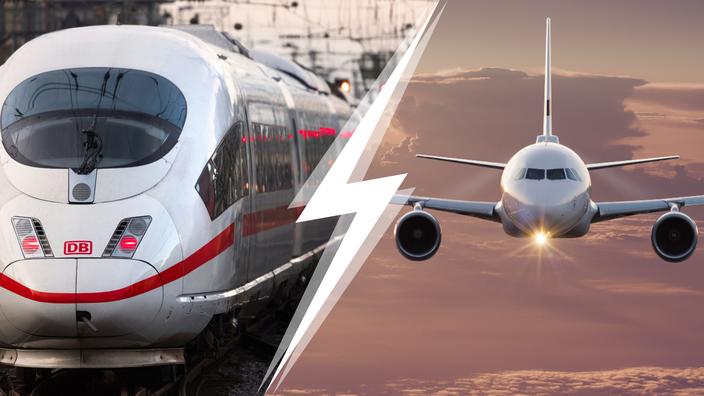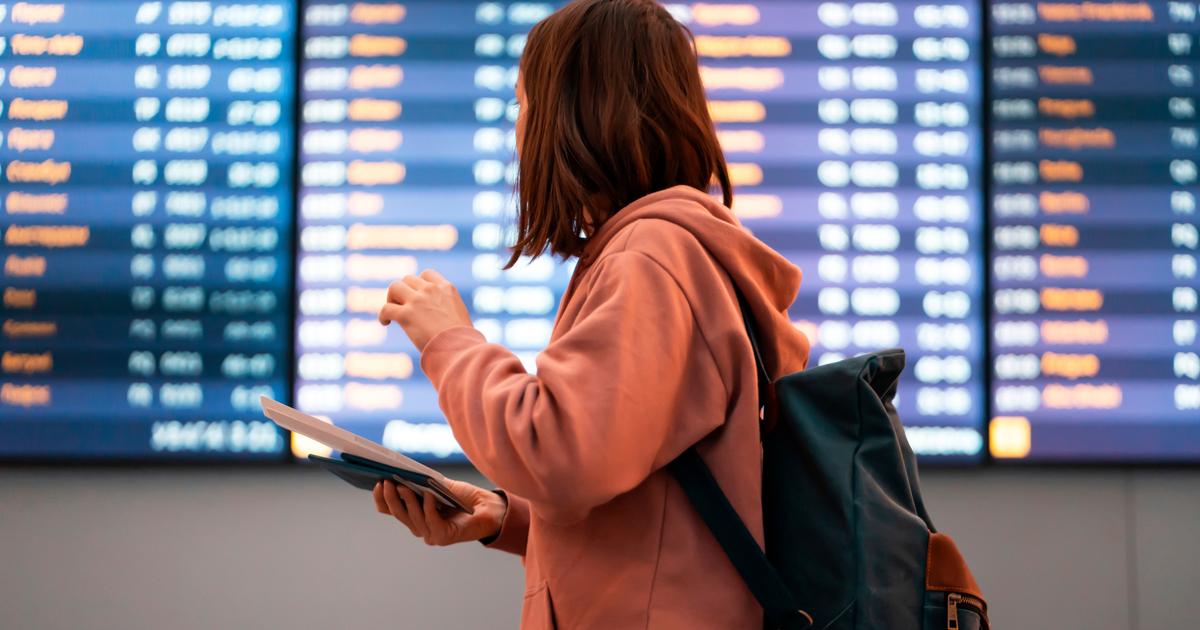Price: plane benefit, but ...
In
air transport
, competition allows travelers to benefit from a wide range of prices.
For a one-way trip to Europe, it starts at € 10 for ultra low-cost (Ryanair, Volotea, etc.), € 30 for low-cost (Transavia, easyJet, Vueling, etc.) and € 50 for airlines. traditional (Air France, Lufthansa ...).
Additional costs are often added to the plane ticket: taxi or airport shuttle, checked baggage, choice of seat, etc.
As
rail carriers
are in a monopoly situation in most European countries, train fares are less varied and often higher than for air. But you can find advantageous prices as long as you book very early, go during off-peak periods or have a reduction card. € 29 is the minimum price for a one-way ticket offered by SNCF and its European subsidiaries (Eurostar, Thalys, TGV Lyria) on its international connections from Paris to around ten capitals or metropolitan areas, including London, Brussels, Amsterdam, Cologne, Geneva, Milan or Barcelona. It is also the appeal price of a Paris-Milan with the Italian company Trenitalia, which launched in France on December 18, 2021.
Certain fares and itineraries are not sold on oui.sncf: for international journeys, it is also better to do your research on multimodal travel platforms (Trainline, Omio ...) or the websites of foreign companies (Renfe, CFF, ÖBB ...).
Example with Germany where on the Deutsche Bahn website, it is easy to find tickets under € 50 for a trip between Paris Gare de l'Est and any city across the Rhine.
Read alsoFrom Lisbon to Moscow, 15 destinations in Europe to go by train
Duration: it depends
The commute from the city center to the airport and security checks extend the total duration of air travel.
Anna Berkut - stock.adobe.com
If we only take into account the actual travel time, the plane is unbeatable. But unless you live in front of an airport, you have to add the transfer from the city center to the terminal (there and back), baggage check-in and retrieval and security checks ... On its website, Air France advises, for example, to be at the airport "
two hours before your flight departs to drop off your luggage and carry out all police and security formalities with confidence
". Boarding time extended by additional checks linked to the health context ...
From city center to city center, the high-speed train thus becomes faster than the plane on routes such as Paris-London (2 h 17 by train) and Paris-Amsterdam (3 h 20) ... shouldn't you live more than an hour from the station?
The two modes of transport show a slight difference on the Paris-Barcelona (6:40 a.m.), Montpellier-Madrid (6 hours) and Marseille-Brussels (5:30 a.m.) connections.
The night train, despite long journey times (14 hours between Paris and Vienna), is an advantageous alternative: the journey takes place during sleep time and saves one night in a hotel.
Read alsoThe Paris-Vienna night train has started: all you need to know
On the other hand, the plane prevails on the transverse axes (Nantes-Barcelona, Lyon-Brest ...) neglected by direct rail links (a change in Paris is often necessary). Ditto for more distant European destinations (Scandinavian countries, Baltic countries, Balkans ...) where train journeys involve at least two days of travel and multiple connections.
If we take “useful time” into account, then the train has an undeniable advantage over the airplane. Useful time "
allows users to reclaim their commuting time to work, read, discuss, listen to music, sleep: it is not wasted time, but real time for relaxation, time that can be optimized.
”, Details a study by the Transport Quality Service Authority (AQST) (
1
). Another strong point: the railway provides a fine service of the territories and can thus bring you closer to your place of stay.
Read also Paris-Warsaw, Berlin-Barcelona ... How Germany wants to revive the Trans Europ Express
Comfort and services on board: train advantage
By train, passengers can reclaim their travel time to work, read, listen to music or sleep.
ÖBB / Philipp Horak
By plane, space is maximized.
The distance between each seat is calculated to the nearest centimeter.
Inheriting the middle seat or facing a tilted seat is enough to convince us of the overcrowded cabins.
We can console ourselves with the snack offered and served instead by the on-board staff on traditional companies (in addition on low-cost).
And even if Wi-Fi is more and more often offered in flight, few devices have individual screens on the medium-haul.
On board the trains, travelers can stretch their legs as they wish and dine in the bar car. Wi-Fi and individual electrical outlets (which are common in all classrooms) keep you connected and entertained. People with reduced mobility can travel without leaving their wheelchair, which is almost always placed in the hold on an airplane. Families can stay together thanks to the “family squares” and have access to a nursery space. Some trains, such as the German IC / ICE and the Austrian Railjet, have cars and compartments dedicated to families, with activities and entertainment for children. In Italy, the Frecciarossa de Trenitalia have “silence” (to be calm) and “allegro” (more suitable for families) compartments.
Read also Paris-Lyon: we tested the difference between SNCF and Trenitalia
Safety: airplane advantage
Systematic in airports, security checks are lacking in stations.
Chalabala - stock.adobe.com
Empty your pockets, put your water bottle or shower gel in the trash, let yourself be touched by a security officer… It is a ritual well known to airline passengers.
And also a stressful time for some.
If these checks are time consuming and increase travel time, they have the merit of creating a feeling of security throughout an airplane trip.
Nothing like that in stations. Checking tickets, baggage and identity on boarding are relatively rare, except on certain Thalys (security gates departing from Paris Gare du Nord) and on Eurostars (baggage control and double identity checks on both sides of the Channel). On international routes, identity checks may take place when crossing borders, but rarely upon departure or arrival.
Read also Cabin baggage: these things to know to avoid disappointment at the airport
Luggage: train benefit
In Europe and except on Eurostar, Renfe-SNCF and Thalys, travelers can take as much luggage as they want, with no weight or volume limit, during their train journeys. On international TGVs, only bicycles dismantled and transported in a bag are authorized (at no extra charge). On board a train, skis and nautical boards stored in a bag must not exceed 1.20 mx 0.90 m. The transport of bicycles and pets is free or paid depending on the railway companies. In France, count € 7 for small animals (less than 6 kg) traveling in a bag or basket, or 50% of the full price of a 2nd class ticket, calculated on the basis of the kilometer scale, for dogs of more than 6 kg. But at this price which can quickly climb for a Paris-Marseille,they will just have the right to be seated ... under your feet.
On most airlines, the basic fare ticket includes only one cabin baggage (generally 55x35x25 cm, 10 kg maximum). Additional, heavier and / or oversized baggage is placed in the hold for a charge of € 30 to € 70. But it depends on the companies. On Air France, ski equipment is considered as standard hold baggage. Its transport is therefore included in the price of the ticket (except tickets at the Light rate) if it is the only piece of luggage entrusted. Certain objects (inks, paints, lacquers, sharp objects, camping stoves, etc.) are prohibited on planes for safety reasons, which is not always the case on trains. Finally, on Air France, the transport of an animal is not included in the price of your ticket:count between 40 and 80 € for a flight in mainland France, or between 55 and 200 € for a trip in Europe.
Read also Do you fly with your pet?
Ten things to know
Punctuality: train advantage
In Europe, trains are generally more punctual than planes.
Deutsche Bahn AG / Axel Hartmann
Are we more likely to arrive late by train or plane?
In 2019, 22.6% of medium-haul flights landed or took off more than 15 minutes late in France (with an average delay of 44 minutes), against 14.6% for SNCF international rail links (with a average delay of 32 minutes), according to AQST.
On the sky side, not all airports and airlines are created equal in terms of punctuality.
Air France's intra-European flights posted a punctuality rate of 79.92% in 2019 (against 78.66% on its subsidiary Transavia or 73.08% at easyJet), according to OAG, an agency specializing in data processing. flights.
On the rail side, on average 91% of trains arrived on time in 2017, according to a report from Prime, a platform for rail infrastructure managers in Europe.
Among the 13 countries assessed between 2012 and 2017, the good students are Latvia, Switzerland and the Netherlands, the worst are France (11th position with a punctuality of 87%), Belgium and Italy.
Read alsoSNCF: what protection for passengers in the event of a train delay
Carbon footprint: train advantage
This is a criterion to which travelers are increasingly sensitive and which for several years has fueled hostility towards aircraft. The environmental impact of a trip can be estimated using carbon footprint calculators. Nevertheless, it is difficult to determine with precision the equivalent of CO² emitted by a train or plane passenger. These calculators omit many criteria such as the occupancy rate, the type and age of the devices and the impact of the construction of the infrastructure (stations, terminals, railways, etc.). In addition, depending on the methodology used, the results differ from one calculator to another.
One thing is certain: for long distance, the train is the least polluting means of public transport.
For a journey of 1000 km (for example a Paris-Rome or a Paris-Berlin), each passenger emits the equivalent of 2.4 kg of CO² by high-speed train against 230 kg by plane, according to Ecolab, a dependent service of the Ecological Transition Agency (Ademe).
Either a ratio of one to one hundred.
Read alsoDo you know these rail passes to travel through Europe (and the world)?
Conclusion: the plane for speed, the train for comfort
So, should we prefer the train or the plane?
It all depends on the length of stay planned and the travel experience sought.
From France, most major European cities can be reached in two hours by flight.
Ideal for a city trip of two to four days.
The price war in which airlines are waging makes flights accessible to all budgets.
The train, on the other hand, is better suited to itinerant stays and to travelers who do not have time constraints.
While it remains fairly expensive overall, it offers comfort conducive to relaxation, stops in town centers and serves regions inaccessible by air.
To get an idea, the best thing is to be flexible when leaving by air and returning by rail.
Or vice versa.
(1) This study was carried out to understand the choices and experience of travelers in terms of interurban travel and is interested, in addition to the train and the plane, to the bus, to carpooling and to the private car.
Originally published in November 2020, this article is subject to an update.





